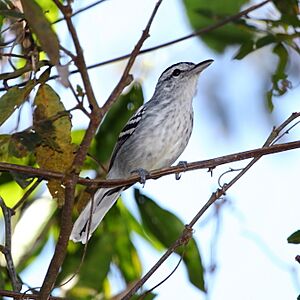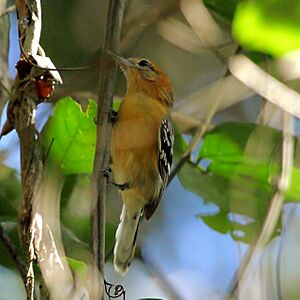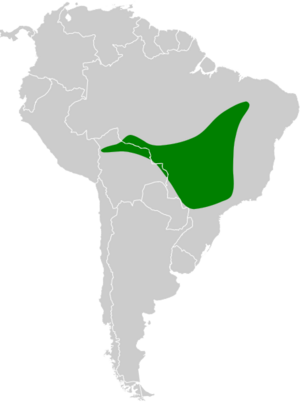Large-billed antwren facts for kids
Quick facts for kids Large-billed antwren |
|
|---|---|
 |
|
| Male at Dourado, São Paulo State, Brazil | |
 |
|
| Female at Poconé, Mato Grosso State, Brazil | |
| Conservation status | |
| Scientific classification | |
| Genus: |
Herpsilochmus
|
| Species: |
longirostris
|
 |
|
The large-billed antwren (Herpsilochmus longirostris) is a small bird found in South America. It lives in countries like Bolivia and Brazil. This bird gets its name from its beak, which is a bit bigger than other birds in its family. It is part of a group of birds called "typical antbirds."
Contents
About the Large-billed Antwren
How Scientists Name Birds
Scientists like August von Pelzeln first described the large-billed antwren in 1868. They gave it the scientific name Herpsilochmus longirostris. This helps everyone know exactly which bird they are talking about!
This bird is related to other antwrens. It seems to be closest to the pectoral antwren. Some scientists even think they are part of a "superspecies," which means they are very, very similar. The large-billed antwren is also "monotypic," meaning it is the only species in its group that does not have different subspecies.
What Does It Look Like?
The large-billed antwren is about 12 to 13 centimeters (5 inches) long. It weighs around 12 to 14 grams (about half an ounce). As its name suggests, its beak is heavier than most other antwrens.
Male birds have a black top of the head and neck. They have a long whitish stripe above their eye. A thin black line goes through their eye. Their cheeks are grayish. Their back and rump are gray. They have a black and white patch between their shoulders. Their tail feathers are black with white tips. Their wings are black with white tips on some feathers. Their throat and belly are mostly white. They have tiny black spots on the sides of their chest.
Female birds look a bit different. They have a reddish-brown top of the head. Their cheeks and upper body are grayish with a hint of cinnamon. Their neck, throat, and belly are cinnamon-colored. Their wings and tail look similar to the male's.
Where Does It Live?
The large-billed antwren lives in the southern parts of the Amazon rainforest area. You can find it in northern Bolivia, in the Beni and Santa Cruz regions. In Brazil, it lives in the south-central to northeastern parts. This includes states like Mato Grosso, Tocantins, and Paraná. It can also be found in southern Ceará and Piauí.
This bird likes to live in different kinds of forests. These include forests that lose their leaves in certain seasons. It also lives in forests along rivers (gallery forests) and in areas with palm trees. It does not seem to prefer any special height in the forest. In Bolivia, it often lives in small patches of forest within open grasslands called cerrado. It lives at heights from about 150 to 1,100 meters (500 to 3,600 feet) above sea level.
Behavior of the Large-billed Antwren
Movement and Home
Scientists believe the large-billed antwren stays in the same area all year round. It does not migrate to other places.
What Does It Eat?
The large-billed antwren eats insects and probably spiders. It looks for food alone, in pairs, or with its family. Sometimes, it joins groups of different bird species that feed together.
It usually searches for food between 1.5 and 10 meters (5 to 33 feet) above the ground. Sometimes, it goes as high as 15 meters (50 feet). It moves actively and carefully. It usually catches its prey by picking it off leaves, stems, and vines. It reaches out or lunges from its perch to grab food. It also makes short flights to reach leaves. Occasionally, it picks up prey from the ground. This bird is not known to follow army ants.
Reproduction and Life Cycle
Not much is known about when the large-billed antwren breeds. It seems to lay eggs from September to December in western Brazil. One nest found was a small cup. It was made of leaves, fungal threads, and plant fibers. This nest was placed about 1.5 meters (5 feet) above the ground in a small tree. We do not know much else about how this bird raises its young.
How Does It Communicate?
The large-billed antwren's song is a high, fast, chattering sound. It starts by rising in pitch and then goes down and slows at the end. Usually, the male sings, and the female quickly answers him. Its calls include a fast, three-note sound where the notes get shorter and lower. It also makes a sudden, downward-sloping note, similar to other birds in its family.
Status and Conservation
The IUCN (International Union for Conservation of Nature) has evaluated the large-billed antwren. They have listed it as a species of "Least Concern." This means it is not currently in danger of disappearing. It lives across a large area. Its population size is not fully known, but it is thought to be decreasing. However, no immediate big threats have been found.
This bird is considered uncommon to fairly common in most places it lives. It is common along the Transpantaneira road in the Pantanal wetlands of Mato Grosso, Brazil. Its home range includes several large protected areas in both Bolivia and Brazil. Scientists believe it is "of medium sensitivity to human disturbance." This means it can handle some changes from human activity, but too much disturbance could affect it.


